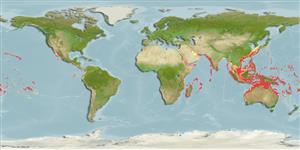>
Acanthuriformes (Surgeonfishes) >
Chaetodontidae (Butterflyfishes)
Etymology: Forcipiger: Latin, forceps = instrument of the pincers kind used for seizing and holding objects, esp. In surgical and obstetric operations + latin, gero = to carry; 1634 (Ref. 45335).
More on authors: Jordan & McGregor.
Issue
FishBase common name changed from Longnose butterfly[ ]fish FAO/ASFIS: Ref. 131312 ) to Forcepsfish (AFS: Ref. 130874) because it is used forForcipiger longirostris (and longirostris = long nose).
Environment: milieu / climate zone / depth range / distribution range
Ekologi
laut berasosiasi dengan karang; nir-ruaya; kisaran kedalaman 0 - 145 m (Ref. 89467). Tropical; 36°N - 32°S, 30°E - 79°W
Indo-Pacific: Red Sea and East Africa (Ref. 12484) to the Hawaiian and Easter islands, north to southern Japan, south to Lord Howe Island; throughout Micronesia. Eastern Pacific: southern Baja California, Mexico and from the Revillagigedo and Galapagos Islands (Ref. 5227, 11482).
Size / Weight / umur
Maturity: Lm ? range ? - ? cm
Max length : 22.0 cm TL jantan/; (Ref. 9710); Umur maksimum dilaporkan: 18 Tahun (Ref. 72479)
Duri punggung (Keseluruhan (total)) : 12 - 13; duri punggung lunak (Keseluruhan (total)) : 19 - 25; Duri dubur: 3; Sirip dubur lunak: 17 - 19.
Common in exposed seaward reefs but also found in lagoon reefs (Ref. 9286). Benthopelagic (Ref. 58302). Solitary or in small groups of up to 5 individuals (Ref. 9286). Adults usually in pairs (Ref. 48636). Feed on a wide variety of animal prey including hydroids, fish eggs, small crustaceans but prefers tube feet of echinoderms, pedicilaria of sea urchins, and polychaete tentacles (Ref. 1602). Oviparous (Ref. 205), monogamous (Ref. 52884). Form pairs during breeding (Ref. 205). Second most important export in Hawaii (Ref. 37816). Minimum depth reported taken from Ref. 128797.
Distinct pairing (Ref. 205). Monogamous mating is observed as both obligate and social (Ref. 52884).
Myers, R.F., 1991. Micronesian reef fishes. Second Ed. Coral Graphics, Barrigada, Guam. 298 p. (Ref. 1602)
Status IUCN Red List (Ref. 130435: Version 2024-1)
ancaman kepada manusia
Harmless
penggunaan manusia
Perikanan: tidak ada kepentingan; Akuarium: Komersial
Alat, peralatan
laporan khas
muat turun XML
Sumber internet
Estimates based on models
Preferred temperature (Ref.
123201): 24.3 - 28.8, mean 27.5 °C (based on 710 cells).
Phylogenetic diversity index (Ref.
82804): PD
50 = 0.6250 [Uniqueness, from 0.5 = low to 2.0 = high].
Bayesian length-weight: a=0.01995 (0.00906 - 0.04395), b=3.01 (2.83 - 3.19), in cm total length, based on all LWR estimates for this body shape (Ref.
93245).
Trophic level (Ref.
69278): 3.1 ±0.2 se; based on diet studies.
Daya lenting (Ref.
120179): Tinggi, Waktu penggandaan populasi minimum kurang dari 15 bulan (Preliminary K or Fecundity.).
Fishing Vulnerability (Ref.
59153): Low vulnerability (12 of 100).
Nutrients (Ref.
124155): Calcium = 77.3 [40.2, 116.8] mg/100g; Iron = 0.735 [0.446, 1.180] mg/100g; Protein = 18.5 [17.4, 19.7] %; Omega3 = 0.129 [0.079, 0.208] g/100g; Selenium = 44.4 [24.8, 80.8] μg/100g; VitaminA = 44.4 [12.5, 154.3] μg/100g; Zinc = 1.25 [0.86, 1.79] mg/100g (wet weight);
